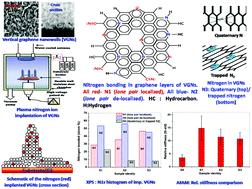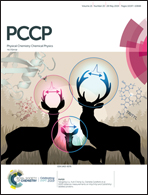Understanding the structural and chemical changes in vertical graphene nanowalls upon plasma nitrogen ion implantation†
Abstract
Shallow plasma ion implantation is a versatile method for nitrogen incorporation in vertical graphene nanowalls (VGNs). However, the defects introduced by the process and the preference of nitrogen to occupy various locations in the 2D layered structure make the characterization complex. We have simplified the analysis of 2 kV nitrogen plasma ion implanted VGNs by correlating the binding energy of N1s electrons with the chemical state of nitrogen as lone-pair localized (N1), lone-pair de-localized (N2) and quaternary nitrogen (N3). This new approach helps to understand the electronic nature of implanted VGNs, based on the occupancy of structural locations by nitrogen. The C1s photoelectron spectra and G-peak intensity normalized comparison of the entire Raman spectra revealed large scale sp2C to sp3C conversion and generation of defects upon implantation. The increase in relative stiffness of implanted VGNs, as observed in atomic force acoustic microscopic studies, was correlated with the formation of graphitic CNx (N2), crosslinking of layers by nitrogen (N3) and interlayer sp3 carbon.


 Please wait while we load your content...
Please wait while we load your content...